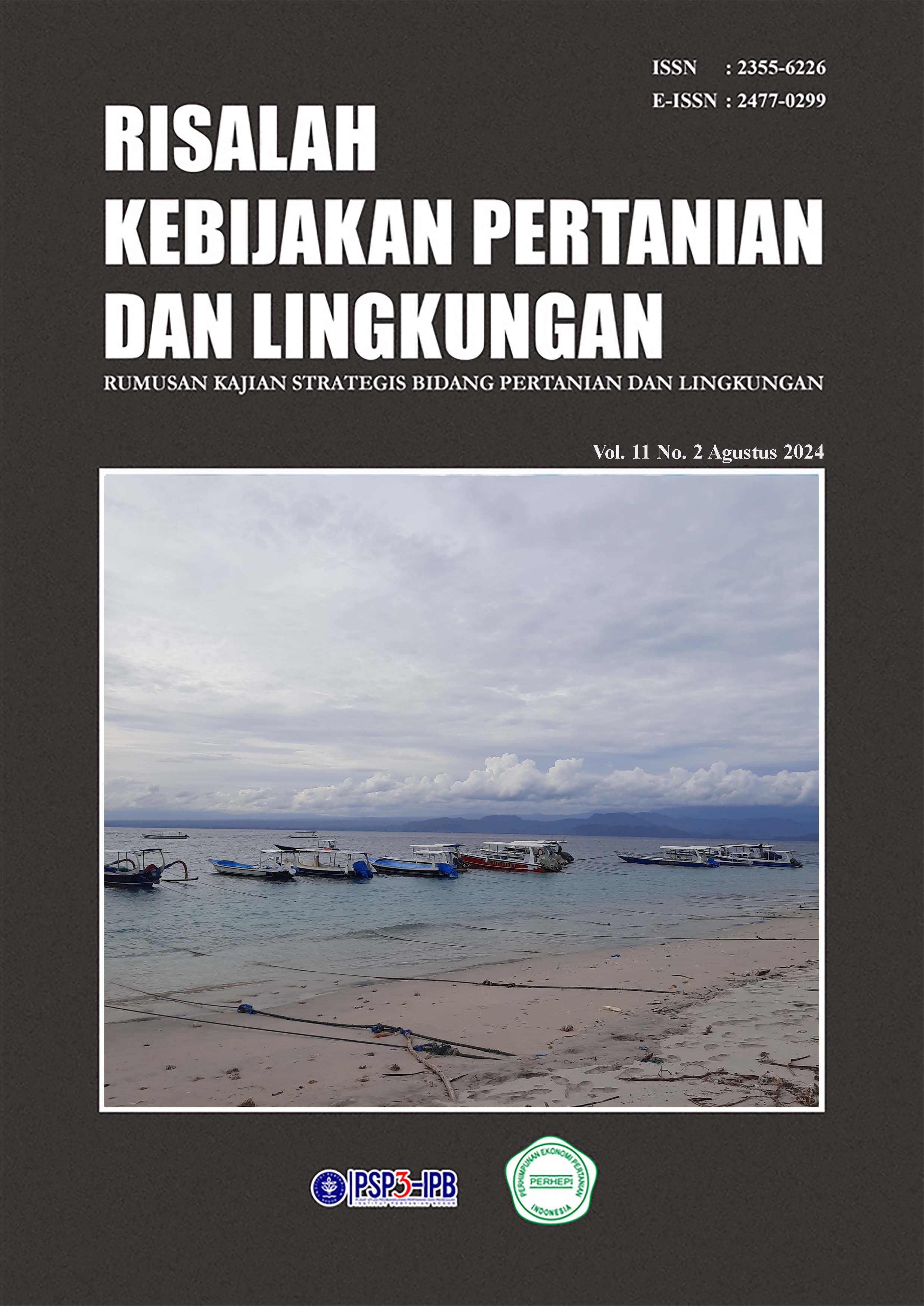ANALISIS STRATEGI KEBIJAKAN PENGELOLAAN LINGKUNGAN KARENA PENINGKATAN LAHAN TERBANGUN DI KOTA PEKANBARU
Abstract
The expansion of built-up areas in Pekanbaru City represents a complex phenomenon with broad impacts on the urban environment. This study aims to formulate appropriate environmental management strategies in response to this trend. Utilizing the Analytical Hierarchy Process (AHP) method, the study identifies land use changes between 2010 and 2022. Data from the Ministry of Agrarian Affairs and Spatial Planning/National Land Agency (ATR/BPN) indicates a significant decrease in forest or shrubland areas, while built-up areas, particularly in the Tampan and Tenayan Raya districts, have increased. The analysis suggests that effective policy strategies for managing the environmental impacts of built-up land should prioritize environmental preservation, economic collaboration, ecological citizenship movements, and community participation. Policy recommendations should focus on implementing effective policies, strengthening economic collaboration, conserving biodiversity, and empowering communities in environmental decision-making. These strategies are expected to enhance the quality of the built-up environment and, overall, improve the well-being of the people in Pekanbaru City.
Metrics
Downloads
References
Almegi A, Eizlan M. 2023. Pengaruh keberadaan kampus terhadap perkembangan lahan terbangun di wilayah pinggiran Kota Pekanbaru. Media Komunikasi Geografi. 24(1), 15-28. doi: 10.23887/mkg.v24i1.56869. DOI: https://doi.org/10.23887/mkg.v24i1.56869
Angraini F, Selpiyanti S, Walid A. 2020. Dampak alih fungsi lahan terhadap degradasi lingkungan: studi kasus lahan pertanian sawah menjadi lahan non pertanian. Jurnal Swarnabhumi. 5(2): 35-42. doi: 10.31851/swarnabhumi.v5i2.4741. DOI: https://doi.org/10.31851/swarnabhumi.v5i2.4741
Anisyaturrobiah A. 2021. Dampak urbanisasi terhadap penyediaan pemukiman dan perumahan di wilayah perkotaan Indonesia. Jurnal Ekonomi Bisnis dan Akuntansi. 1(2): 43-54. doi: 10.55606/jebaku.v1i2.136. DOI: https://doi.org/10.55606/jebaku.v1i2.136
Anjulian L. 2017. Analisis Perubahan Penggunaan Lahan di Kecamatan Pekanbaru Kota Tahun 2007 Dan Tahun 2014. Doctoral dissertation, UNIMED DOI: https://doi.org/10.24114/tgeo.v6i2.8673
Arifasihati Y, Kaswanto RL. 2016. Analysis of land use and cover changes in Ciliwung and Cisadane Watershed in three Decades. Procedia Environmental Sciences. 33: 465–469. doi: 10.1016/j.proenv.2016.03.098. DOI: https://doi.org/10.1016/j.proenv.2016.03.098
Barrow CJ. 1991. Land Degradation: Development and Breakdown of Terrestial Enviroment. Great Britain (UK): Cambridge University Press.
Efendi H, Kaswanto RL, Wardiatno Y, Bengen DG, Setiawan BI, Pawitan H, Soetarto E, Damayanthi E, Arifin, HS, Widanarni. 2022. Water Front City: Kota Tepian Air Ramah Lingkungan. Policy Brief Dewan Guru Besar IPB University.
Kaswanto RL, Ilmi RM, Nurhayati HSA. 2023. Waterfront city management to realize low carbon landscape in Pekanbaru City, Indonesia. International Journal of Conservation Science. 14(3): 1151-1162. doi: 10.36868/IJCS.2023.03.24. DOI: https://doi.org/10.36868/IJCS.2023.03.24
Mubarokah A. dan Hendrakusumah E. 2022. Pengaruh alih fungsi lahan perkebunan terhadap ekosistem lingkungan. Jurnal Riset Perencanaan Wilayah dan Kota. 2(1): 1-14. DOI: https://doi.org/10.29313/jrpwk.v2i1.754
Munawir A, June T, Kusmana C, Setiawan Y. 2019. Dynamics factors that affect the land use change in the lore lindu national park. Proceeding of SPIE 11372. Event: Sixth Internasional Symposium on LAPAN-IPB Satelite. Bogor. DOI: https://doi.org/10.1117/12.2542812
Munawir A, June T, Kusmana C, Setiawan Y. 2021. Environmental institution improvement using Interpretative Structural Modeling (ISM) Techniques in Lore Lindu National Park (LLNP), Central of Sulawesi Province Indonesia. Plant Archives Enviromental Science Journal. 21(1): 251–260. doi: 10.51470/PLANTARCHIVES.2021.v21.S1.395. DOI: https://doi.org/10.51470/PLANTARCHIVES.2021.v21.S1.395
Munawir A, June T, Kusmana C, Setiawan Y. 2022. SEBAL Model to Estimate Biophysics and Energy Flux Variable: Availability of Evapotranspiration Distribution Using Remote Sensing in Lore Lindu National Park. IOP Conference Series Earth and Environmental Science. 950: 012022. doi: 10.1088/1755-1315/950/1/012022. DOI: https://doi.org/10.1088/1755-1315/950/1/012022
Munawir A, Rusdiyanto E, Fathar IR, Nurhasanah, Mierzwa JC. 2023. Ozone method recycling domestic waste to prevent waste water pollution. Journal of Ecological Engineering. 24(12): 16–28. doi: 10.12911/22998993/171805. DOI: https://doi.org/10.12911/22998993/171805
Nurjannah S, Amzu E, Sunkar A. 2017. Peran kawasan bernilai konservasi tinggi bagi pelestarian keanekaragaman hayati di Perkebunan Kelapa Sawit Provinsi Riau. Risalah Kebijakan Pertanian dan Lingkungan Rumusan Kajian Strategis Bidang Pertanian dan Lingkungan. 3(1): 68-77. https://journal.ipb.ac.id/index.php/jkebijakan/article/view/15237. DOI: https://doi.org/10.20957/jkebijakan.v3i1.15237
Nurmala N, Hutagaol MP. 2022. Membandingkan pengaruh infrastruktur terhadap kemiskinan di kawasan barat dan timur Indonesia serta implikasi kebijakan. Risalah Kebijakan Pertanian dan Lingkungan Rumusan Kajian Strategis Bidang Pertanian dan Lingkungan. 9(3): 188-207. doi: 10.29244/jkebijakan.v9i3.34834. DOI: https://doi.org/10.29244/jkebijakan.v9i3.34834
Qisthina N, Kaswanto RL, Arifin HS. 2023. Analysis of land cover change impacts on landscape services quality in Cisadane Watershed, Tangerang City. In IOP Conference Series: Earth and Environmental Science 1133(1). IOP Publishing. DOI: https://doi.org/10.1088/1755-1315/1133/1/012051
Rahayu S, Badiah. 2021. Strategi konservasi Tumbuhan Hoya di Bodogol, Cagar Biosfer Taman Nasional Gunung Gede Pangrango Melalui Promosi Ekowisata. Risalah Kebijakan Pertanian dan Lingkungan Rumusan Kajian Strategis Bidang Pertanian dan Lingkungan. 8(3): 176-187. doi: 10.29244/jkebijakan.v8i3.28034. DOI: https://doi.org/10.29244/jkebijakan.v8i3.28034
Rusdiyanto E, Munawir A. 2023. New built land threat of martapura river – implementation of environmental sustainability in Banjarmasin City, South Kalimantan, Indonesia. J. Ecol. Eng. 24(5): 276–287. doi: 10.12911/22998993/161759. DOI: https://doi.org/10.12911/22998993/161759
Saputra MN, Agus F, Hidayah A. 2022. Prediksi perubahan penutup lahan menggunakan integrasi Celullar Automata dan Analytical Hierarchy Process (AHP)(Studi Kasus: Kota Pekanbaru). Journal of Urban Regional Planning and Sustainable Environment. 1(1). https://journal.uir.ac.id/index.php/JURPS/article/view/9051.
Wirosoedarmo R, Haji ATS, Zulfikar F. 2018. Analisa perubahan tata guna lahan dan pengaruhnya terhadap pencemaran di Brantas Hulu, Kota Batu, Jawa Timur. Jurnal Sumberdaya Alam dan Lingkungan. 3(1), 33-39.
Copyright (c) 2024 RISALAH KEBIJAKAN PERTANIAN DAN LINGKUNGAN: Rumusan Kajian Strategis Bidang Pertanian dan Lingkungan

This work is licensed under a Creative Commons Attribution 4.0 International License.
PUBLICATION ETHICS
Jurnal Risalah Kebijakan Pembangunan Pertanian dan Lingkungan (JRKPL) is a peer-reviewed journal publishing original research to develop a coherent and respected network of landscape architecture knowledge. JRKPL committed to upholding the highest standards of publication ethics that clarifies ethical behavior of all parties involved in publishing a scientific article in JRKPL.
As publisher of JRKPL, PSP3-LPPM IPB and PERHEPI takes its duties of guardianship all stages of publishing process and we recognize our ethical and other responsibilities.
Duties of Authors
An author should not publish manuscripts describing essentially the same research in more than one journal or primary publication. Submitting the same manuscript to more than one journal is unacceptable and constitutes unethical publishing behavior. In general, an author should not submit for consideration in another journal a previously published paper.
Authorship should be limited to those who have made a significant contribution to the manuscript and should be listed as co-authors. Where there are others who have participated in certain substantive aspects of the research project, they should be acknowledged as contributors. The corresponding author should ensure that all co-authors have seen and approved the final version of the paper and have agreed to its submission for publication.
The authors should ensure that they have written entirely original works, and if the authors have used the work and/or words of others, that this has been appropriately cited or quoted. Plagiarism are include passing off another paper as the author own paper, copying or paraphrasing substantial parts of another paper (without attribution) and claiming results from research conducted by others. Plagiarism constitutes unethical publishing behavior and is unacceptable. Plagiarism detected works will be banned for further publication procedure.
The authors acknowledge that they have disclosed all and any actual or potential conflicts of interest with their work or partial benefits associated with it. All sources of financial support for the project should be disclosed. Potential conflicts of interest should be disclosed at the earliest stage possible.
Duties of the Editorial Board
Review Process
JRKPL is committed to objective and fair double-blind peer-review to prevent any actual or potential conflict of interests between the editorial and review personnel and the reviewed material. JRKPL chooses reviewers based on their expertise (whose most closely matches the topic of the paper). At least 2 reviewers are invited to evaluate a manuscript. In cases of controversy or disagreement regarding the merits of the work, an additional review will be solicited. The JRKPL editor mediates all interaction between authors and reviewers, and the review results owned by JRKPL.
Publication Decisions
The editor of a peer-reviewed JRKPL is responsible for deciding which of the articles submitted to the journal should be published. The validation of the work in question and its importance to researchers and readers must always drive such decisions. The final decision on article acceptance based on reviewer's opinions, suggestions, and comments. The editor may confer with other editors or reviewers in making this decision.
Fair Play
JRKPL evaluates manuscripts only based on the intellectual content. No race, gender, sexual orientation, religious belief, ethnic origin, citizenship, or political philosophies of the authors are considered in the evaluation process.
Confidentiality
JRKPL assure the confidentially of the manuscripts, actors, and other related information on the publishing process. Only corresponding author, reviewers, potential reviewers, other editorial advisers, and the publisher are allows for the information.
Disclosure
Unpublished materials disclosed in a submitted manuscript must not be used in an editor's own research without the express written consent of the author. Privileged information or ideas obtained through peer review must be kept confidential and not used for personal advantage.
Duties of reviewers
(1) Objectivity: Reviewer should provide written and unbiased feedback to the authors, personal criticism of the author is inappropriate. Reviewer comments should be clearly with supporting arguments indicating whether the writing is concise and relevant
(2) Expertise: Reviewer who feels unqualified to review the research reported in a manuscript or knows that its prompt review will be impossible should notify the editor and excuse himself from the review process.
(3) Acknowledgement of sources: Reviewer suggest relevant published work that has not been cited by the authors to improve the quality of the manuscript,
(4) Confidentiality: Reviewer should maintain the confidentiality of the review process. Privileged information or ideas obtained through peer review must be kept confidential and not used for personal advantage.
(5) Disclosure and conflict of interest: Unpublished materials disclosed in a submitted manuscript must not be used in a reviewer own research without the express written consent of the author. Reviewers should not consider manuscripts in which they have conflicts of interest resulting from competitive, collaborative, or other relationships or connections with any of the authors, companies, or institutions connected to the papers.























